An Overview of the Chevrolet Cavalier and Its Top Features
Chevrolet is an automobile maker that rose to popularity by manufacturing vehicles ranging from subcompact cars to heavy trucks. Chevrolet is regarded as one of the global leaders in automobiles. The Chevrolet Cavalier is a series of compact sedans produced by the carmaker. It was one of the most popular and important products in the company’s line of vehicles. Here are some interesting facts about Chevrolet Cavalier that are unknown to many.
Chevrolet Cavalier
Chevrolet introduced the Cavalier in 1981 as an affordable sedan. The vehicle was an alternative to the Toyota Corolla and also served as a replacement for Chevrolet Monza.

First generation (1982–1987)
The basic structure included a unibody structure and a good suspension. Body styles of the vehicle include a three-door hatchback coupe, 2 door notchback coupe, 3 & 4 door sedans, and a 4-door station wagon. For the 1982 models, the trim packages of the vehicles could be optioned with accent stripes, aluminum alloy wheels, and two-tone paint. The 1983 models had a new engine option, and a 5-speed manual debuted as an option.
Second generation (1988–1994)
The vehicle’s steering column got redesigned in 1988, while trunk designs were introduced for coupes and sedans of the second generation. The rear shoulder belt became standard for all models in the next year. A new self-aligning steering wheel was introduced to reduce injuries during collisions. In 1990, door-mounted automatic front seats were added. The vehicles of 1991 got a unique design that included new bumpers, headlights, tail lights, and a redesigned interior. Small changes, such as the Alpha Tech ignition lock cylinder, were also introduced in the same year. In 1992, anti-lock brakes were added as a standard feature. The 1993 model bought minimal changes, such as a rear glass window for the convertible and styling changes in the trims. Additional changes, including a redesigned power locking system and climate control interface, were made in the 1994 model year.
Third generation (1995-2005)
The 1995 model year brought redesigns in the form of a longer wheelbase, roomier interior, expanded dimensions, and more aerodynamics. Some basic styles, such as bumper integrated grill, remained unchanged. Convertible, sedan, and coupe models were gone, and 2-door coupe and 4-door sedan remained the only option at first, only for the convertible to return a year later. Apart from the convertible’s return, standard daytime running lamps were introduced in 1996. Dual airbags became standard for the third generation. 1997 – 1999 models were carryovers and didn’t experience many changes. A noticeable difference was that there were no LS convertibles. All the convertibles became Z24s. For the 2000 model, the vehicle was provided with an improved grille, a newly updated dashboard, bigger headlights, and a new Cavalier badge. In 2002, the four-speed automatic became the primary offering, dropping the three-speed. 5-speed was still available for two-door vehicles. 2003 witnessed minor changes, such as an upgraded grill and a new taillight panel. The new Ecotec motors became the only engine choice for vehicles until 2005, and they significantly increased performance.
The car was hailed for delivering remarkable performance, handling, and power alongside a comfortable commute. The Chevrolet Cavalier, during its market debut, was available under an array of style options. In its prime, the automobile was considered a reliable car that came at affordable prices and fascinating features.

